Tigridia pavonia
Can’t decide between a flower with colorful spots or one with solid hues? With the tiger flower, you don’t have to – you can enjoy a gorgeous combo of both!
Whether planted as an annual or cultivated as a multiseason perennial, Tigridia pavonia is a beautiful bloomer for your summer garden.

We link to vendors to help you find relevant products. If you buy from one of our links, we may earn a commission.
It’s easy to care for, resistant to pests and diseases, and capable of surviving in the face of many environmental stressors.
As anyone who’s been the guilty party in a failed romance will tell you, it’s sometimes all too easy to mess up something beautiful.
But whereas relationship advice is subjective and oftentimes complicated, tiger flower teachings are much more straightforward… not to mention way less drama-filled.
In this guide, we discuss all aspects of T. pavonia care, from propagation to cultivation. By its end, you’ll be well-equipped to grow these stunning blooms with ease.
Here’s the gist of what we’ll be getting into:
What You’ll Learn
What Are Tiger Flowers?
A member of the Iridaceae family alongside irises, gladiolus, and crocuses, Tigridia pavonia is a bulbous herbaceous perennial flower that hails from Guatemala, Honduras, Mexico, and El Salvador, and it has also naturalized in Ecuador and Peru.
This plant is hardy in USDA Zones 7 to 10.
Reaching heights of 18 to 24 inches and spreads of 12 to 18 inches, tiger flowers are easily identified by their colorful, three- to six-inch blooms, which consist of three larger petals and three smaller ones.
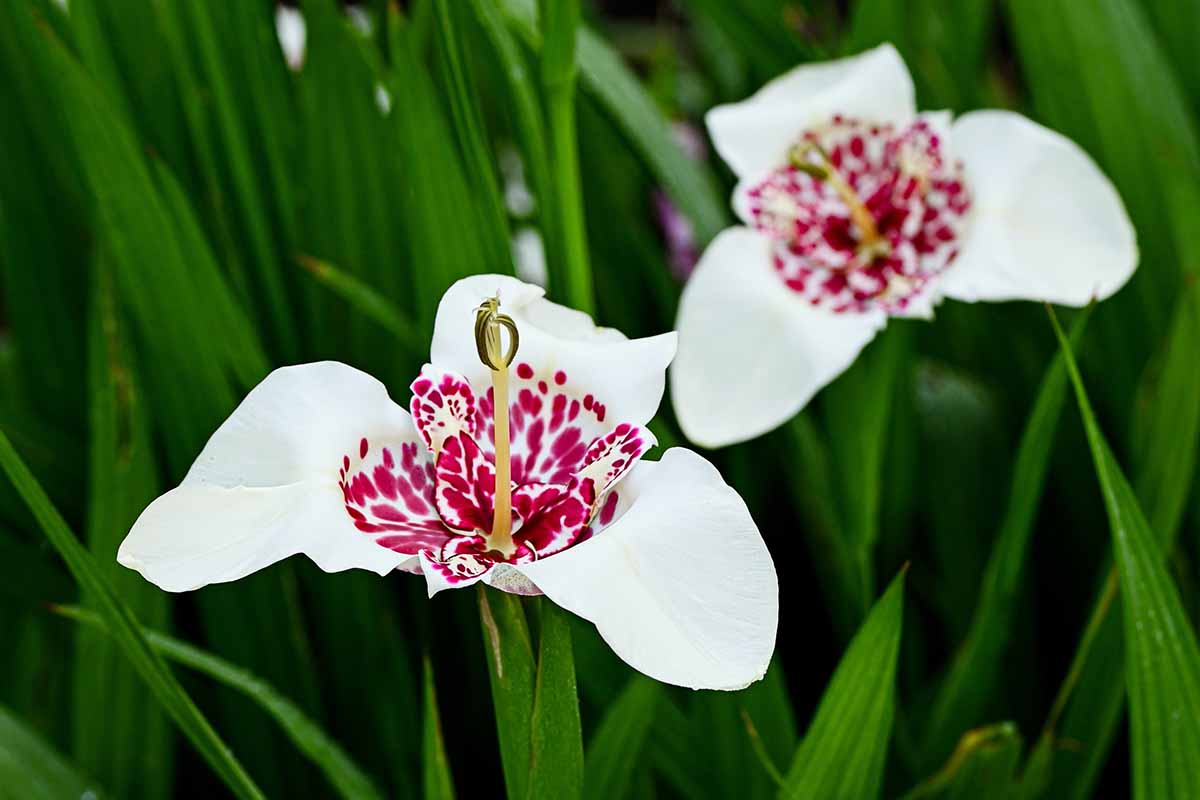
Regardless of their specific color, the inner petals are speckled with rather striking dots, while the outer petals feature solid, patternless color.
Each bloom lasts for a single day, but multiple buds ensure that flowers are blooming all throughout the two- to four-week bloom period, which usually begins around midsummer.
The blooms are also very attractive to insect pollinators, who make the production of seed pods possible in fall.
Emerging from the plant’s base are three to six narrow, sword-shaped leaves. These are green and visibly ribbed with parallel, longitudinal ridges.
Growing close to the central stem, this foliage provides a verdant backdrop that highlights the flowers quite nicely.
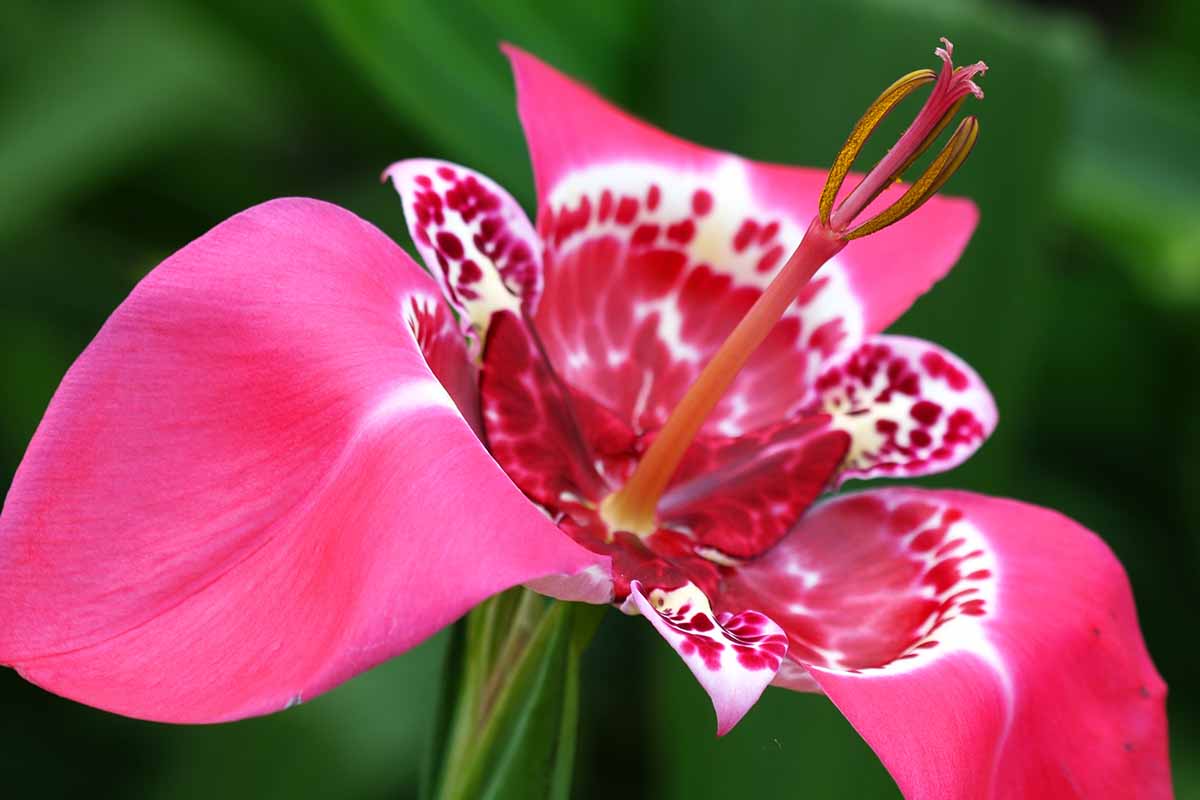
All of this aboveground growth emerges from the plant’s corms, which are different from true bulbs.
While true bulbs have layered scales, corms have a center which is composed of solid tissue.
If eaten raw, these small corms taste rather unpleasant. But they’re edible and quite delicious when cooked!
The taste is sweet with a floury texture, akin perhaps to a sweet potato or a sweet chestnut.
It is said that Aztecs cultivated these plants for their edible corms. I’m sure the appearance of these plants was a nice aesthetic treat, too!
Propagation
If you’re not familiar with the Iridaceae family, then caring for tiger flowers is the perfect way to become acquainted.
But first, you’ll need to propagate some, whether it’s by sowing seeds, planting corms, or separating offsets from the mother plant.
From Seed
Sowing T. pavonia seeds is definitely the most time-consuming route, since it can take a couple years for a seed to develop into a bloom-producing specimen.
You also risk your specimens not growing true to type, thanks to the inherent variability of sexual reproduction. But if you love seed sowing, then more power to ya.
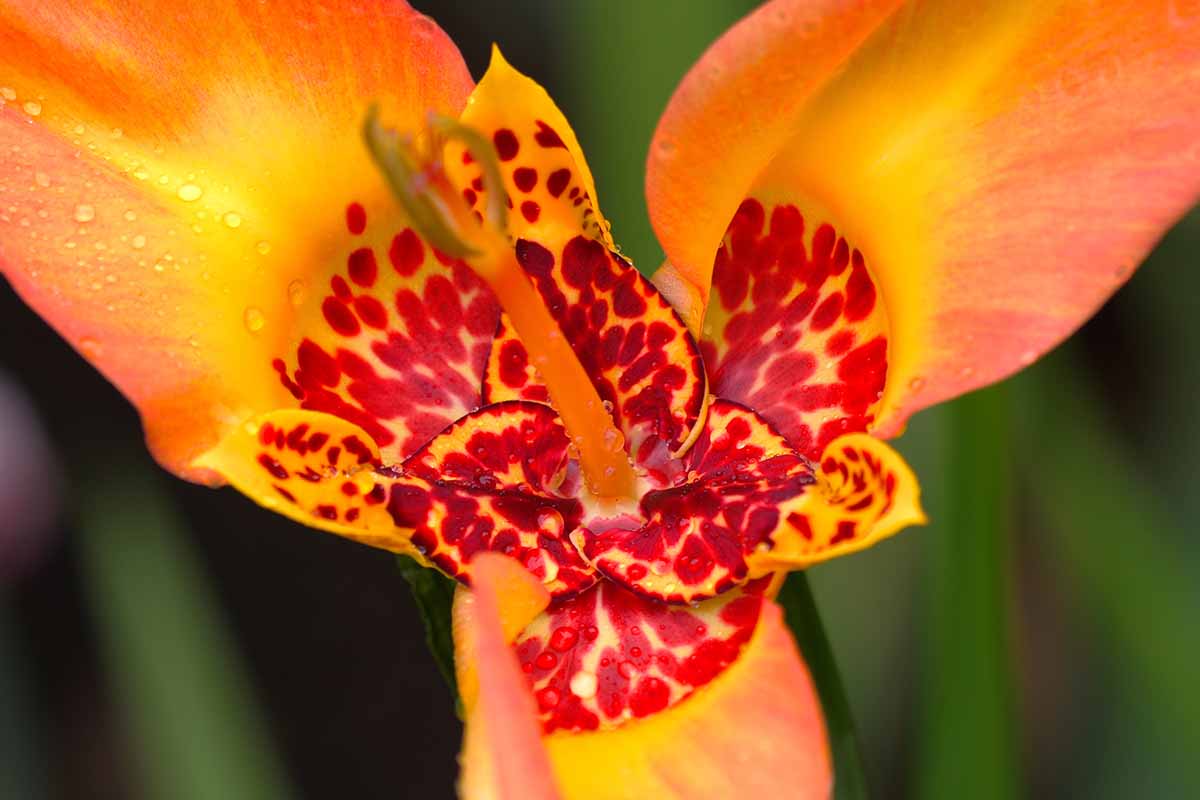
First things first: you’ll need seeds. You can either purchase them – ideally from a reputable vendor – or gather them from established T. pavonia plants.
Preferably ones that you have access to… don’t go stealing seed pods from anyone’s tiger flowers, now!
Once you see the seed pods in fall, wait until they dry before removing them from the parent plant with a sharp and sterile blade.
When they’re dry, break them open and clean the seeds by running water over them in a sieve.
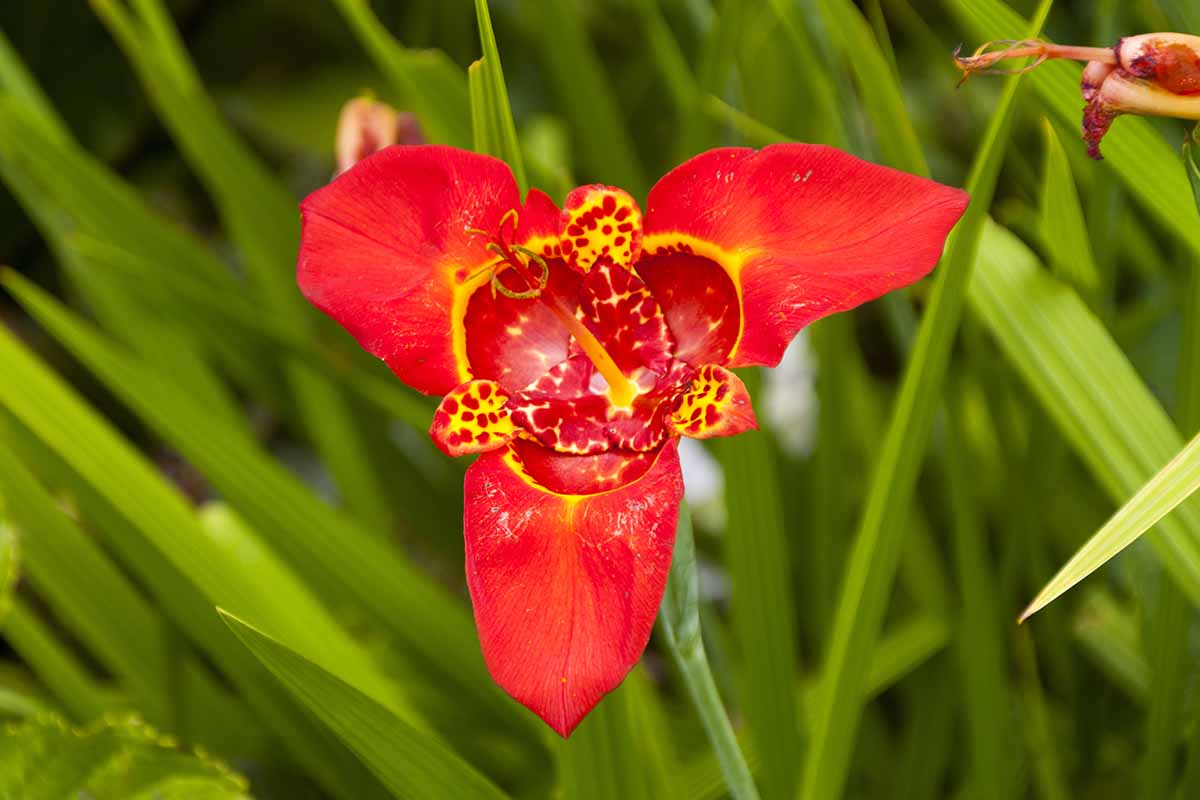
Set them out at room temperature to dry, then store the dried seeds in a cool, dry place until you’re ready to sow them.
Fill a seed tray with a seed-starting mix and spread the seeds out across the surface, making sure to keep them all at least an inch apart from each other.
Mist the seeds with a spray bottle filled with water, then cover the tray with clear plastic. Set the tray in bright, indirect light indoors, making sure that temperatures are at least 70°F.
If you need help with that, these bottom-heat mats from Gardener’s Supply Company can boost seedling temperatures 10 to 20 degrees higher than the ambient temperatures.
Keep the media moist via watering until the seeds sprout in two to six weeks.
At this point, remove the plastic and continue to care for the seedlings by maintaining a moist growing medium.
Once the seedlings grow three inches tall, they can be moved into their own individual four-inch containers. If you have a limited number of containers, pick the strongest-looking seedlings and cull the rest.
Continue to grow them indoors through their first winter, making sure to repot as necessary and to keep the media around the seedlings moist all the while.
The following spring – after the last frost, if frost occurs in your Zone – they’ll be ready for hardening off outdoors.
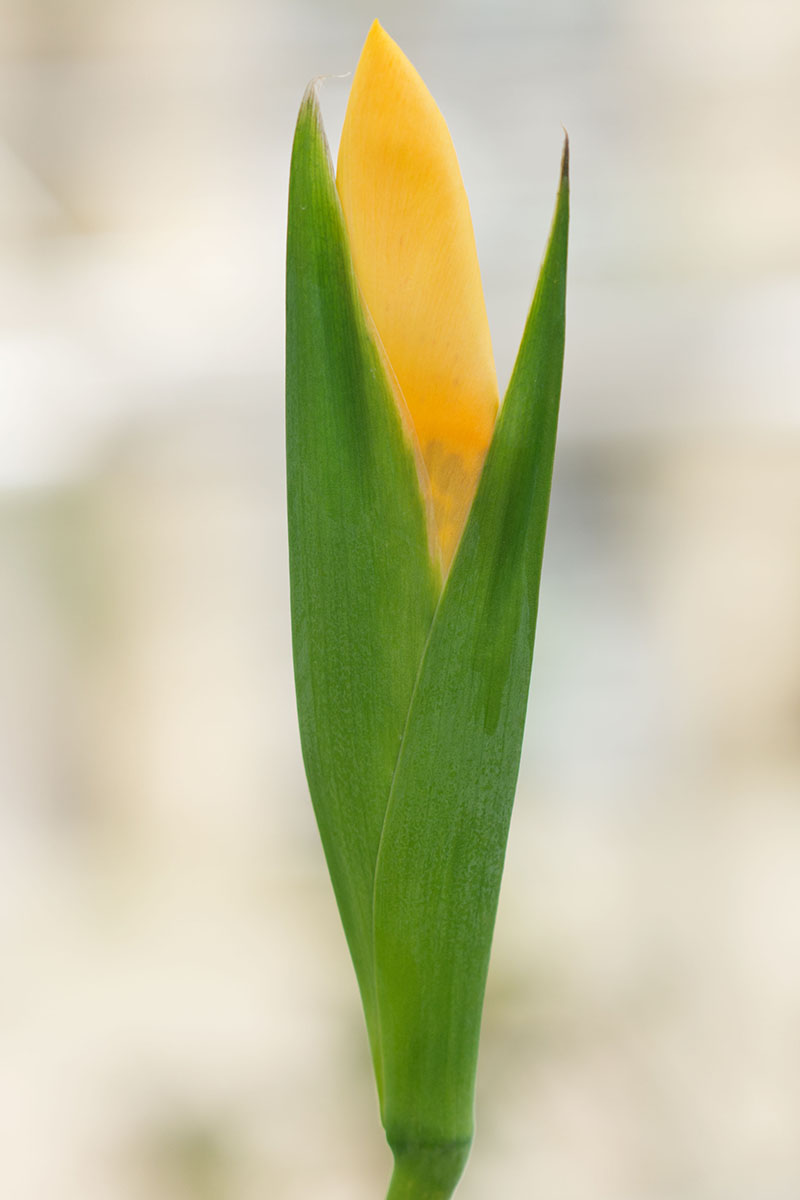
To do so, leave the seedlings outside in full sun for thirty to sixty minutes before bringing them back inside. Add an additional half to full hour each day until your plants can last a full day outside.
At this point, your container plantings are free to lounge outside, or you can put them in the ground. To do the latter, prepare fertile, well-draining sites with a pH of 5.5 to 7.5 and a sandy to loamy texture. Make sure they’ll receive full, bloom-fueling sun exposure!
Plants purchased from a nursery can be transplanted the same way.
Dig holes so that the corm part of the root system will be at least three to four inches deep when planted.
Space the holes four to six inches apart, transplant your specimens, then backfill with adjacent soil.
Water in your plantings, and presto! They should produce blooms a year or two after sowing from seed.
From Corms
Propagating corms is a lot quicker than starting from seed, because the carbohydrates required to fuel growth are right there in the corms.
Corm-wise, you’ll want to either purchase new ones, or reuse ones that you’ve lifted the season prior.
This is a necessity if you live in a region with cold winters and you wish to see the return of these beautiful blooms from one year to the next.
Since primo planting time is in spring after the final frost, you’ll want to save any acquired corms in a cool, frost-free location until that point.
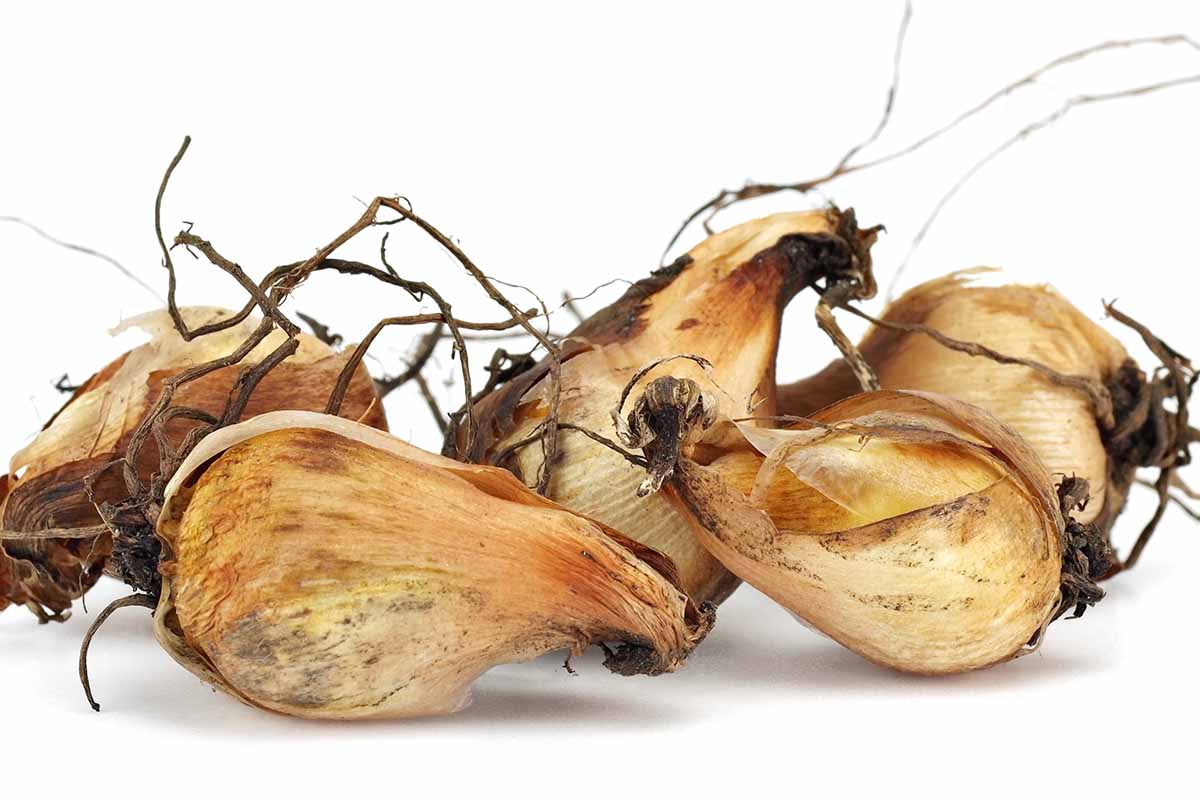
Come spring, plant the corms in a similar medium to what you would use for seeds: well-draining and fertile, with a pH somewhere between 5.5 and 7.5.
Plant the corms three to four inches deep, and space them four to six inches apart. Containerized corms should be planted in their own individual containers.
Keep the media surrounding the corms moist from here on out, and provide full sun.
From Offsets
A cool thing about T. pavonia corms is that they’ll grow little offsets, i.e. baby cormels that develop off of the main corm.
Come early autumn, these can be removed from the mother plant and transplanted individually.
To do this, dig up a large, mature specimen once it has finished flowering and take a look at its root system.
With your hands, gently separate any sizable offsets from the main corm. Replant the main corm, then immediately plant and care for the offsets just as you would full-size corms.
How to Grow Tiger Flowers
Well, you’ve got some tiger flowers in the ground now! Let’s learn how to make these cool cats purr, on a physiological level.
Climate and Exposure Needs
T. pavonia is hardy in USDA Zones 7 to 10, which means it’ll come back for multiple seasons when planted in these climates.
Flowering will be more prolific towards the warmer end of this range, less so in the cooler parts. Either way, the plant is remarkably tolerant of heat and humidity.

You can still plant these in Zones 6 and below, but they’ll behave like annuals and perish by their first winter unless you lift the corms for storage and replant the following spring.
Full sun is imperative to maximize blooming, but don’t worry – the plants will do alright in partial shade, especially in warmer climates.
Soil Needs
We’ve touched on the ideal soil for tiger flowers, but it’s worth restating: fertile, well-draining, and with a pH of 5.5. to 7.5.
Texture-wise, a sandy and/or loamy soil is optimal, and can provide many of the aforementioned qualities as a bonus.
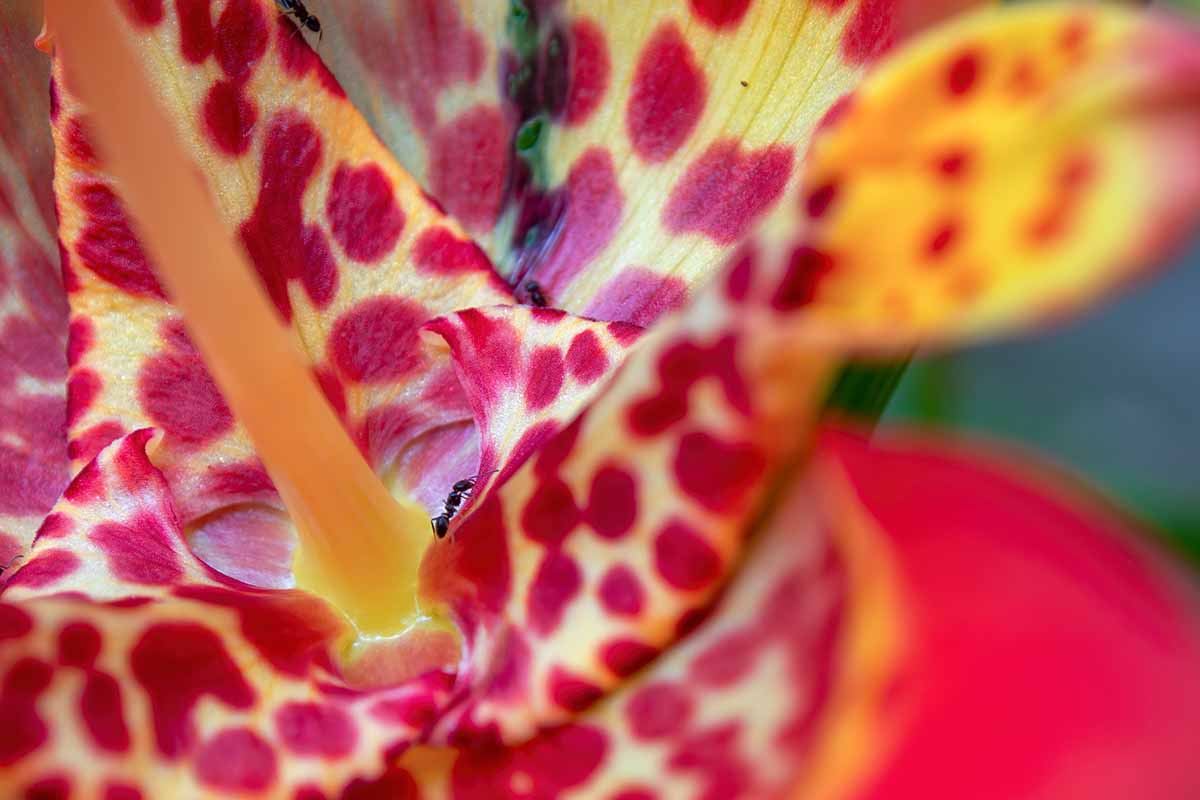
Prior to planting, working an inch or two of organic matter into the soil will provide increased fertility, water-holding capacity, and workability, i.e. friability.
Annually amending your soil with the stuff will keep these benefits coming year after year.
Water and Fertilization Needs
T. pavonia needs to sit in constantly moist soils until it becomes established.
After establishment, these plants can tolerate periods of drought, so providing constant moisture is no longer a requirement.
To meet the plant’s fertilizer needs, apply a low-nitrogen fertilizer in late spring, a bit before flowering.

Lilly Miller Bulb and Bloom Food
If you need a specific product, try this four-pound bag of slow-release, 4-10-10 NPK fertilizer from Lilly Miller, available from Amazon.
Growing Tips
- Full sun is best, but partial shade is tolerable in warmer regions.
- Make sure the soil is very well-draining.
- Provide constant moisture until established.
Maintenance
Tiger flowers are prone to self-seeding, so be sure to pull up any unwanted volunteer seedlings as they pop up.
Deadheading spent blooms as they become apparent will redirect the plant’s energies into producing new flowers rather than seed pods. Plus, it’ll clean up the plant’s appearance.
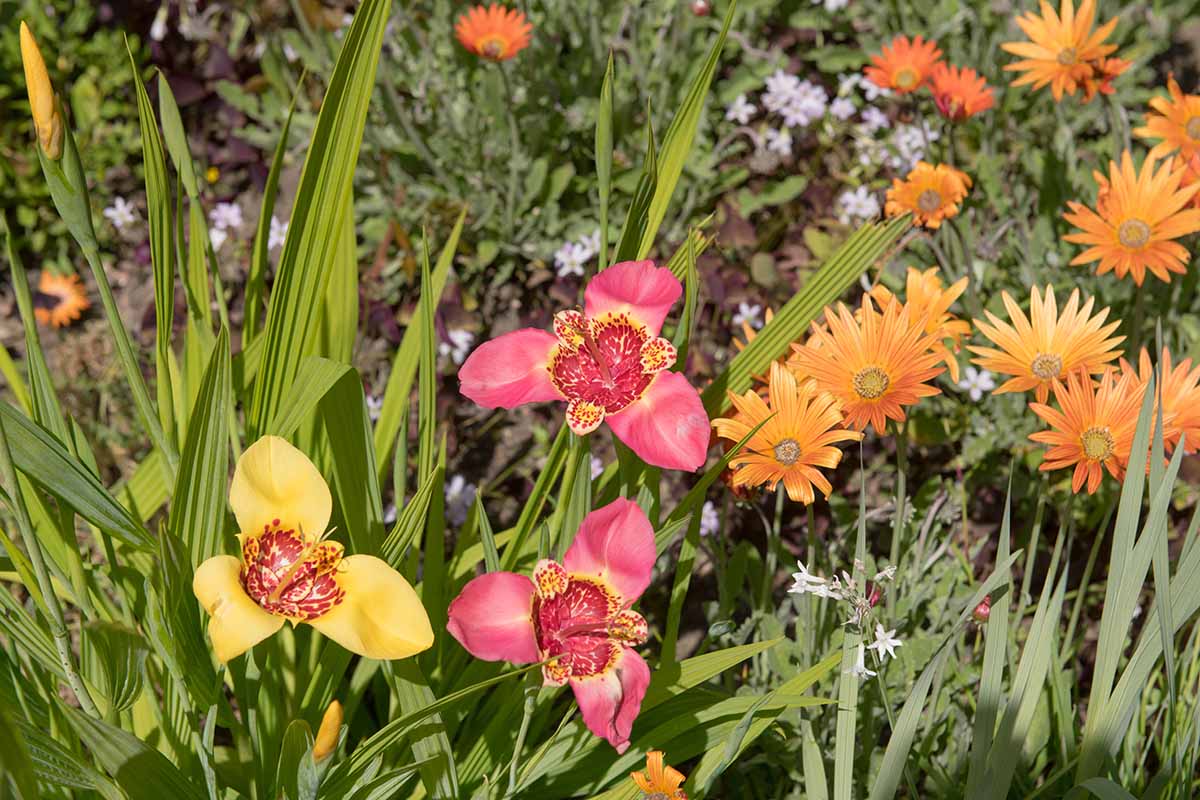
Once flowering is finished and the foliage dies down in fall, the dead leaves can be removed. The corms should be lifted in USDA Zones 6 and below.
In Zones 7 to 10, you can actually leave them in the ground for the winter, provided that you insulate them with a couple inches of mulch.
If you’re lifting corms, you can store them indoors for replanting next year. Any damaged or unhealthy-looking ones should be disposed of.
Clean the lifted corms, cut the stems an inch above the crown, trim off roots, and pick off any cormels.
Set the corms in a shady, well-ventilated area to dry, keeping the ambient temperature at 60 to 70°F. Allow them to dry for one to three weeks – you’ll know that they’re cured once they exhibit a crispy, yet firm feel.
Place the processed corms in mesh baggies – like those you’d find small onions in at the grocery store – and keep them in a dark, dry place that’s consistently kept at 40 to 50°F.
Cultivars to Select
T. pavonia blooms can be found in many different combos of bright, stunning hues.
But these three varieties are especially breathtaking:
Alba
With white outer petals and inner ones speckled with yellow and reddish dots, ‘Alba’ strikes me as particularly glorious.
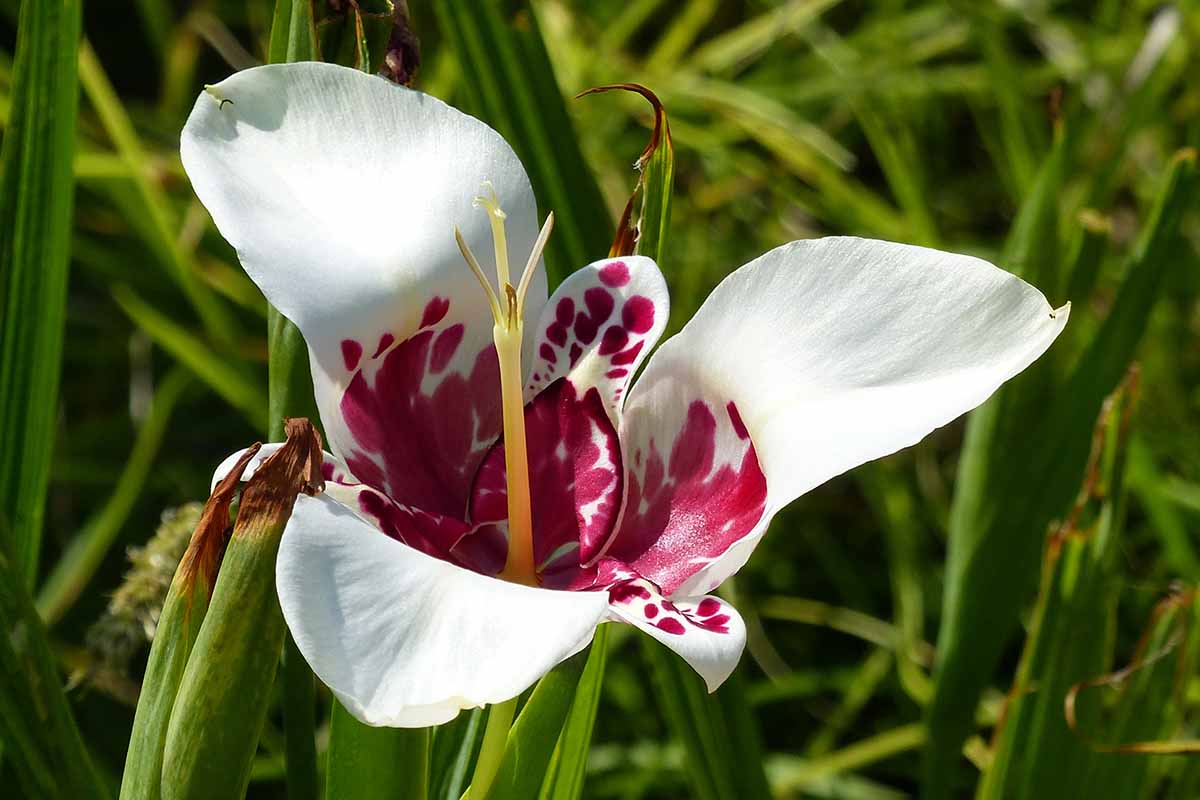
The stark whiteness of the flowers truly stand out in a sea of green.
Aurea
‘Aurea’ has similarly-colored inner petals as ‘Alba,’ but its outer floral segments are a striking golden yellow, rather than pure white.
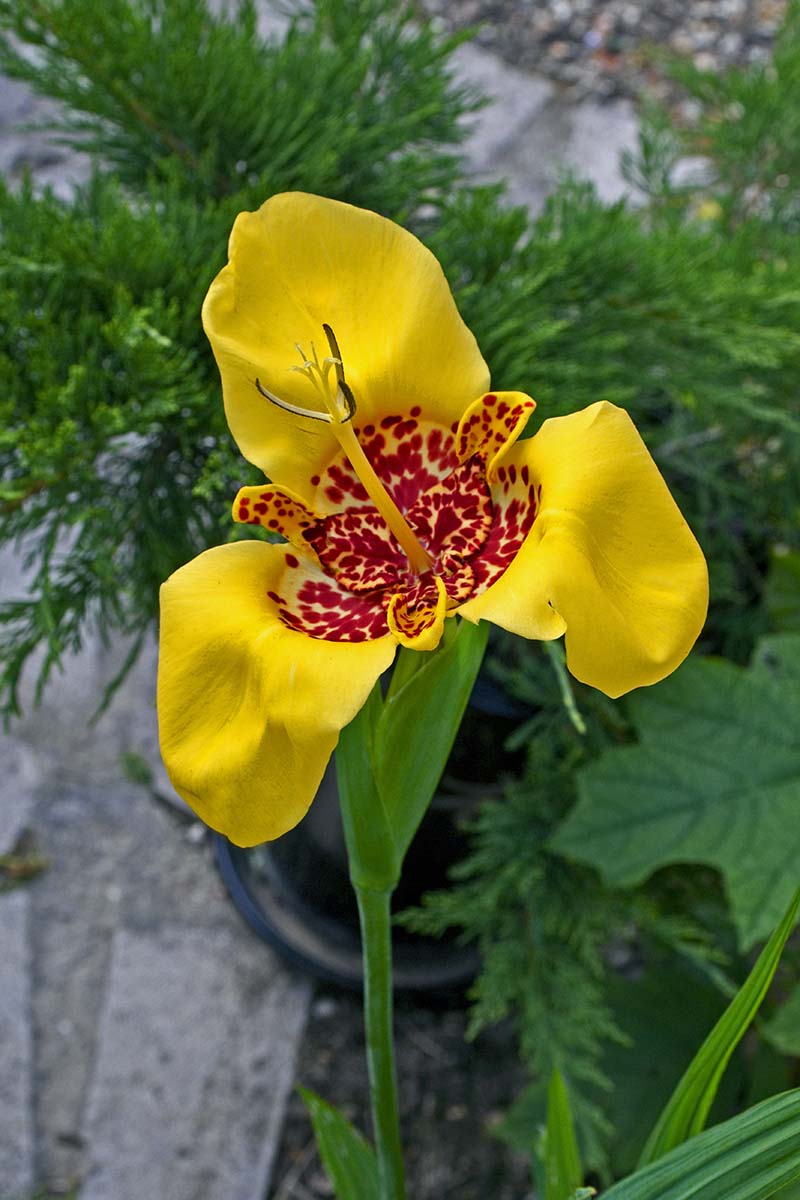
Ain’t it a beaut?
Lilacea
The ‘Lilacea’ variety of tiger flower has a reddish-pink theme going on with both its outer and inner petals.

The former’s color is a solid hue, while the latter is speckled. You can also find traces of white throughout each bloom as an aesthetic accent.
Managing Pests and Disease
Thankfully, T. pavonia doesn’t have many health issues to deal with, as pests and diseases aren’t much of a concern for tiger flowers.
In fact, they have a particular resistance to deer and rabbits!
However, there’s one thing you should be wary of: bulb rot.
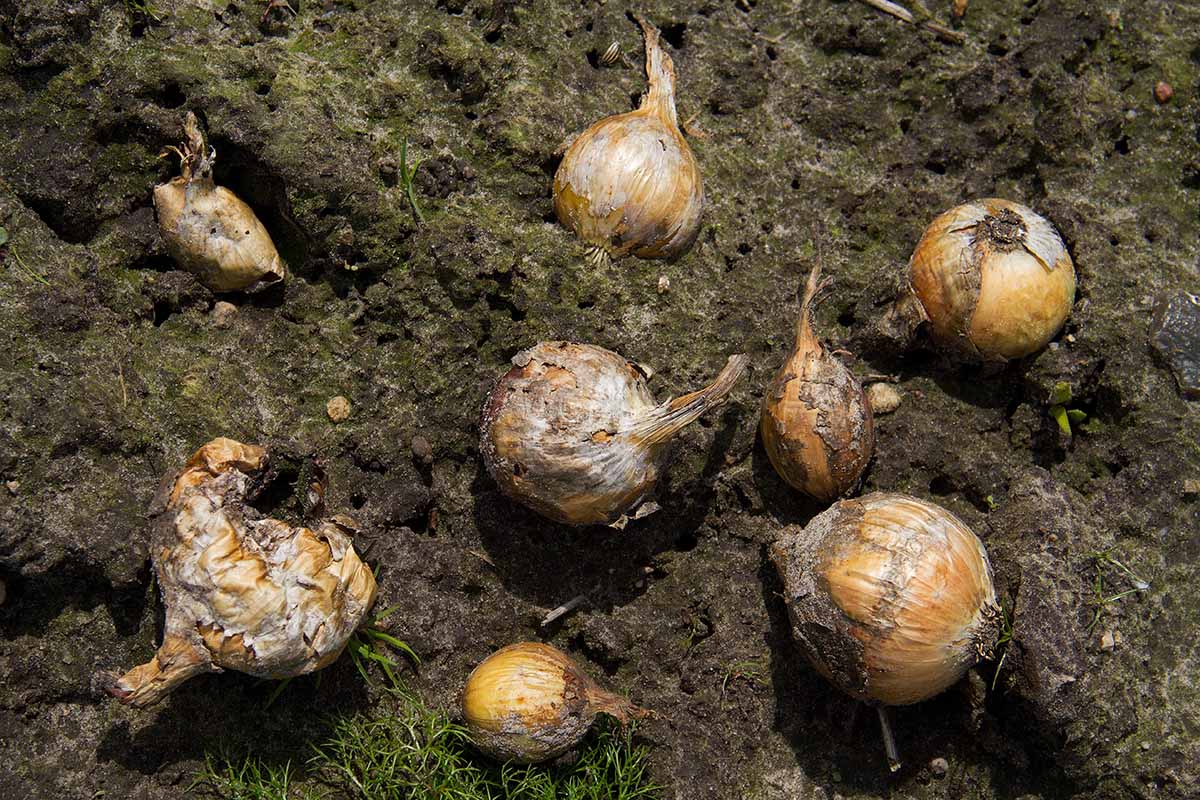
Overly wet conditions, whether from too much irrigation or not enough drainage, can make it so that corms in oversaturated soils fail to receive enough oxygen.
As a result, the corms become necrotic, which spells disaster for their attached roots and aboveground shoots.
Providing proper drainage and watering – think “moist,” not “wet” – from the get-go is the most effective way to protect a tiger flower from bulb rot.
Once a corm becomes rotted-out, all you can do unfortunately is throw it away and learn for next time.
Best Uses for Tiger Flowers
The tiger flower holds its stunning blooms atop long and slender stalks surrounded by narrow leaves… which is definitely pretty, don’t get me wrong.
But T. pavonia will really look its best when it’s planted alongside ground covers, stout and leafy plants, or some other type of plant that can fill in the adjacent bits of empty space.
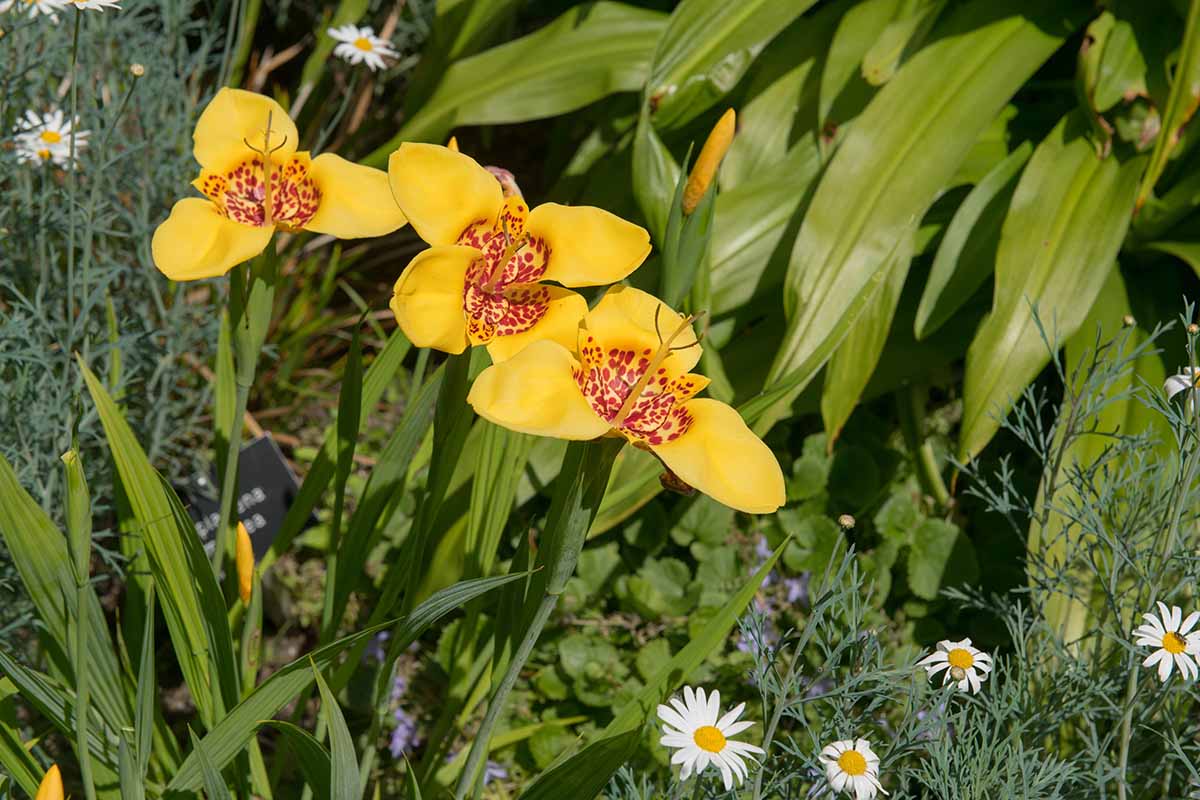
As for where in the garden these fabulous flowers should go, you’ve got a lot of options, such as in the middle of a garden bed, along one as a border, or even in a container.
But wherever you put them, just make sure that they’ll be prominent during their summertime bloom period.
Quick Reference Growing Guide
| Plant Type: | Bulbous herbaceous perennial flower | Flower/Foliage Color: | Orange, pink, purple, red, white, yellow/green |
| Native to: | Central America and Mexico | Maintenance: | Moderate |
| Hardiness (USDA Zones): | 7-10 | Tolerance: | Drought, heat, humidity, partial shade |
| Bloom Time: | Mid to late summer | Soil Type: | Organic, sandy and/or loamy |
| Exposure: | Full sun | Soil pH: | 5.5-7.5 |
| Time to Maturity: | 3-5 months | Soil Drainage: | Well-draining |
| Spacing: | 4-6 inches | Attracts: | Insect pollinators |
| Planting Depth: | 3-4 inches | Companion Planting: | Foliage plants, ground covers |
| Height: | 18-24 inches | Uses: | Beds, borders, containers |
| Spread: | 12-18 inches | Family: | Iridaceae |
| Water Needs: | Moderate | Genus: | Tigridia |
| Common Pests and Diseases: | Bulb rot | Species: | Pavonia |
Tiger Flower Puns Are Corm-y
Just like tiger flowers themselves. I’ve said my piece.
Cheesiness aside, congrats on being able to grow T. pavonia! Your summertime blooms just got a mammoth upgrade in aesthetics.

Have any questions about growing your own tiger flowers? Learned valuable lessons growing your own? Share ’em in the comments section below!
Want to learn how to grow more bulb flowers? These guides provide a solid place to start:

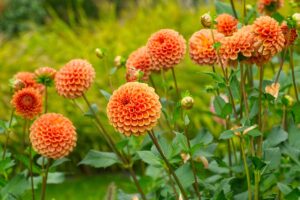


If planted in a pot, how deep of a pot will I need?
At least six to seven inches, I’d say.
Any tips for making the perfect soil mix to plant them in a pot?
I’d say either use an mix of coconut coir/peat moss and perlite/vermiculute, or simply add some gritty sand or perlite to the standard potting mix you’d buy at a garden center.